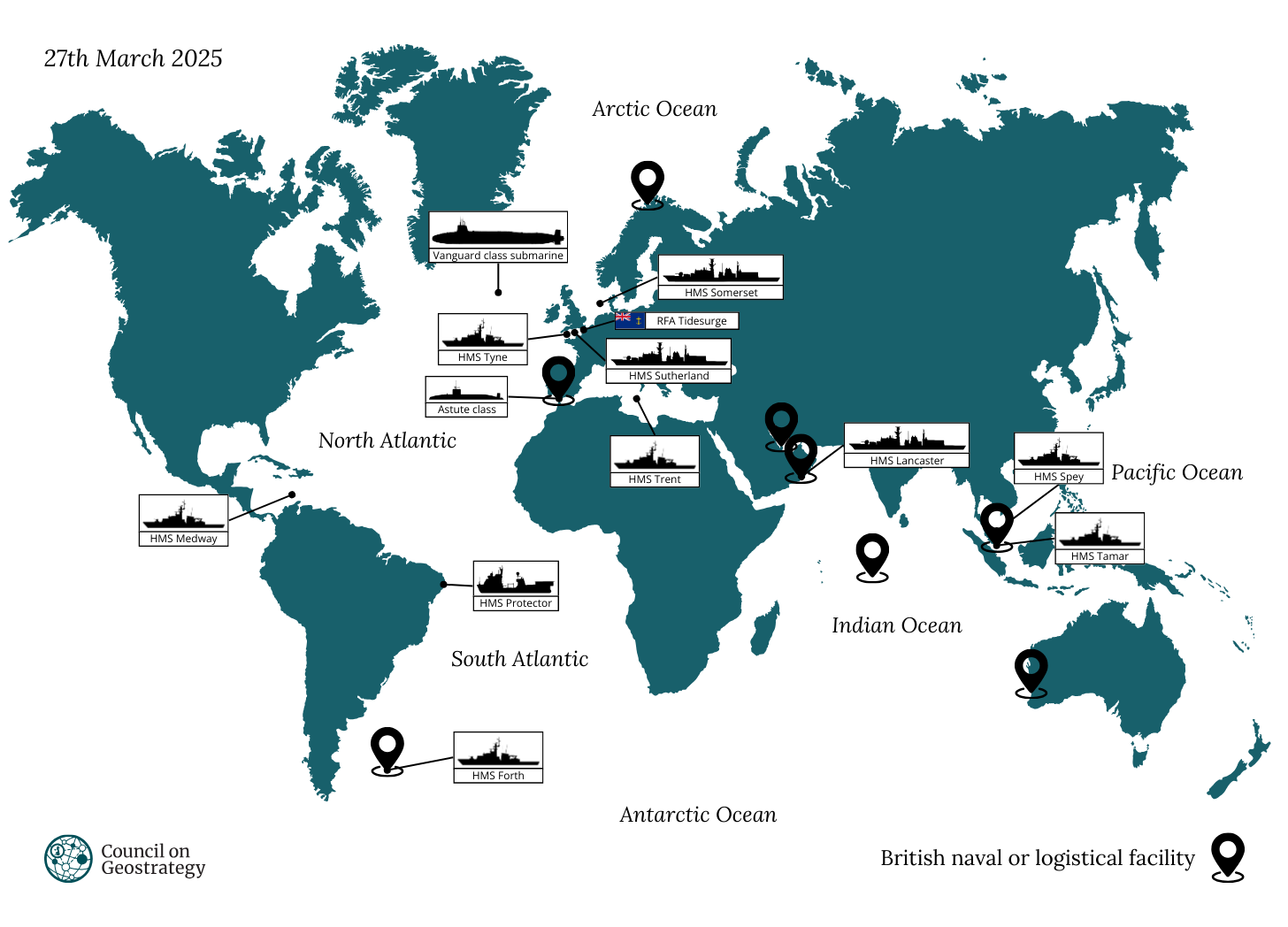
Welcome to The Signal, our new monthly roundup of maritime matters.
(Despite the name of this missive, there aren’t any secret war plans in here, as that’s illegal and nobody tells me anyway!)
Thoughts from your correspondent
HMS Vanguard returned home to Faslane this month after a record-breaking 204 days at sea. She understandably looked a little worse for wear compared to her replacement, which had sailed a few days beforehand after a significant delay in getting ready for sea. Sir Keir Starmer, Prime Minister, and John Healey, Secretary of State for Defence, were there to welcome the crew home and thank them for their service on patrol.
HMS Vanguard and her three sister boats are the core of Britain’s continuous at-sea deterrent (CASD) – nuclear-powered ballistic missile submarines (SSBNs) equipped with Trident II missiles. At least one boat must be out on patrol at all times, submerged throughout to avoid detection, to ensure that the United Kingdom (UK) is always able to use the capability should a crisis arise.
This mission has always been a tough one for the crews – spending so long submerged, with only a short weekly message from loved ones, is a prospect which nobody would relish, and three months used to be considered a difficult patrol for those on board. However, this latest patrol’s record-breaking length is part of a pattern, with the average amount of time that the Vanguard class spends at sea on a patrol doubling over the last three years – the last eight patrols have all been longer than five months. While longer patrols can be argued to be of some benefit to the maintenance and recovery schedules of the remaining three boats, all of which are ageing, spending almost half a year underwater per patrol puts considerable pressure on both the boats themselves and their crews.
The Vanguard class will be replaced from the early 2030s by the Dreadnought class, which will feature more advanced technology and stealth capabilities, coupled with longer endurance. The first of the class, HMS Dreadnought, recently had her keel-laying ceremony in Barrow-in-Furness. This marks the symbolic ‘birth’ of the boat – she has already been under construction for some time – and is a milestone in the programme. HMS Valiant, HMS Warspite and HMS King George VI are to follow.
This critical capability is the ultimate guarantor of the UK’s security and acts as a multiplier for British influence within the North Atlantic Treaty Organisation (NATO), which is why CASD is the central task of the Royal Navy. The continuity and future of the deterrent depends on the Dreadnought programme, and the new boats cannot come soon enough.
Starting from early April, ‘The Signal’ will move to The Broadside, a new online magazine on maritime affairs in the 21st century by the Council on Geostrategy, in cooperation with the Royal Navy Strategic Studies Centre. Please subscribe here!
Tracking the deployments of the Royal Navy
Key movements:
HMS Somerset, HMS Cattistock and RFA Tidesurge shadowed a group of Russian warships heading through the English Channel and North Sea. RFN Severomorsk, a destroyer, RFN Alexander Shabalin, a landing ship, and MV Sparta IV and MV Siyanie Severa, transport ships, were travelling from Tartus in Syria to the Baltic Sea – one of the convoys tasked with evacuating Russian military equipment from Syria following the fall of the Assad regime.
HMS Lancaster seized and destroyed a Class A drug haul worth approximately £5.4 million in the northern Arabian Sea after spotting some suspicious activity with one of its new Peregrine drones. Seeing a Royal Navy frigate and Wildcat helicopter bearing down on your dhow must be quite a shock!
HMS Medway teamed up with USS Normandy, USS Thomas Hudner and HNLMS Groningen for a three-nation passing exercise (PASSEX) in the Caribbean. The crews worked together on communication, manoeuvring, helicopter operations and combined air defence.
HMS Dagger joined vessels from the Gibraltar Defence Police, His Majesty’s (HM) Customs and the Royal Gibraltar Police for a successful combined boat handling and asset protection exercise in territorial waters.
HMS Iron Duke visited Oslo to further cement the Royal Navy’s ties with the Royal Norwegian Navy, including a capability demonstration and a flower ceremony at the Orlogsgasten memorial.
Maritime news from allies and adversaries
Russia: A naval ceasefire in the Black Sea has apparently been agreed by Russia and Ukraine after separate talks with the United States (US). However, given that the Kremlin has made its enactment of the agreement dependent on the lifting of various sanctions, several of which are European rather than American, it remains to be seen whether the ceasefire will actually come into force – and, if it does, how long it will hold. Details are scant from the White House thus far on the specifics of the deal, so this is one to watch closely.
United States: The US Navy is modifying its Arleigh Burke class guided missile destroyers to fill the gaps to be left by the retirement of the Ticonderoga class guided missile cruisers. Giving the destroyers flagship capabilities will allow them to step in for the cruisers to coordinate air and missile defence – the modified USS Winston S. Churchill will be the first destroyer to perform this role when she deploys with the USS Gerald R. Ford carrier strike group to the Middle East later this year.
People’s Republic of China (PRC): A group of People’s Liberation Army Navy (PLAN) warships has circumnavigated Australia and completed live-fire exercises en route. You can read more about what this tells us about Beijing’s intentions in our recent Big Ask, including some thoughts from yours truly.
Australia: The first cohort of sailors from the Royal Australian Navy have qualified as Marine Engineering Officers (Submarine), meaning they can run the engineering watch onboard a British nuclear-powered attack submarine (SSN). This is part of the UK’s commitments under AUKUS, developing the skilled workforce needed to operate Australia’s future SSNs.
France: The Dragoon Fury 2025 exercise saw the French Navy and French Army working together off Toulon on amphibious operations, with the opportunity to test around a dozen uncrewed systems of various kinds launched from FS Tonnerre, a Mistral class Landing Helicopter Dock (LHD). The pressurised tethered balloon looks particularly interesting!
Japan: A new Japan Self-Defence Forces Maritime Transport Group has been established to strengthen Japanese capabilities to deploy troops and to transport fuel, ammunition, supplies and vehicles to front-line bases – particularly in the south west along the Japanese sections of the first island chain in the event of a Taiwan contingency.
South Korea: The South Korean Navy has unveiled the concept design for a new uncrewed vessel for mine countermeasures, under the Navy Sea Ghost Initiative. Given the threat to the country from North Korean naval mines, this will be a very useful and much-needed capability.
Pakistan: The second of eight Hangor class submarines for the Pakistani Navy has been launched from Wuhan. Under the agreement between Pakistan and the PRC, the first four will be built there and the latter four in Karachi under a technology transfer programme. The Hangor class is an export variant of the Type 039B Yuan class submarine.
Naval technology news
RNMB Ariadne has now arrived with the Royal Navy: a 12-metre uncrewed surface vessel (USV) to improve mine countermeasures capabilities. She can be deployed from a harbour or mothership to scour the seabed for mines using sophisticated towed sonar, with automatic target recognition. The USV operates either fully autonomously or remote-controlled from the portable remote command centre.
The demonstrator for CETUS, the Royal Navy’s first Extra Large Underwater Autonomous Vehicle (XLUAV), has now been launched in Plymouth. The vessel will be the largest and most complex uncrewed submersible operated by any European navy, intended for long-endurance autonomous operations with a range of payloads.
Who deserves a mention
BZ to the 1805 Club and the crew of HMS Medway, who took some time out from their duties in the Caribbean to help islanders on Nevis celebrate the return of two items connected with one of Britain’s greatest naval leaders.
The parish register of St John’s, in the southwest of Nevis, records the marriage of a certain Captain Horatio Nelson and Frances ‘Fanny’ Nisbet, a plantation family widow, in 1787. The register was carefully restored by experts at the University of York before being returned to the island, along with a display replica of Nelson’s uniform, by the 1805 Club with the support of ten of HMS Medway’s sailors.
History is important for us all – and naval history, as I am sure the unbiased readers of this will agree, particularly so.
A powerful Navy we have always regarded as our proper and natural means of defense; and it has always been of defense that we have thought, never of aggression or of conquest. But who shall tell us now what sort of Navy to build? We shall take leave to be strong upon the seas, in the future as in the past; and there will be no thought of offense or provocation in that.
– President Woodrow Wilson, 8th December 1914, An Annual Message to Congress.
A reading list on maritime matters
Stairway To Taiwan – The Chinese Amphibious Bridging System by Alex Luck in Naval News – a fantastic analysis and summary of what we know about the new Shuiqiao landing barges spotted in Nansen, and one I wish had come out before I went on Taiwanese television to talk about said barges!
The Lepanto trap: Capacity after the first salvo by Nicolas Mazzucchi in Britain’s World – how navies should avoid the Lepanto trap by better considering industrial capacity and crewing in the knowledge that war will not be short and sharp.
Deciphering French Strategy in the Indo-Pacific by Léonie Allard in War on the Rocks – a comprehensive look at France’s strategy in the region, with a focus on the maritime.
How Trump can strengthen the US Navy by Michael O’Hanlon in The Hill – if, like me, you enjoy a good nerd-out on shipbuilding appropriations rules and contracting, this is one for you.
A reminder that you still have until 23:59 BST, 11th April to submit your contribution to the First Sea Lord’s Essay Competition. I am once again delighted to be on the judging panel and I am looking forward to reading your entries – please do share with anyone you think might be interested!
If you found this Signal useful, please subscribe or pledge your support!
What do you think about this Signal? Why not leave a comment below?























What I would like to know is why only build one submarine at a time?. Surely, in the current geopolitical situation, it would be wise to build at least one more concurrently with the one that has just had the keel laid. Why would also like to know is why only build four?, expensive by any measure but don’t we need more?.